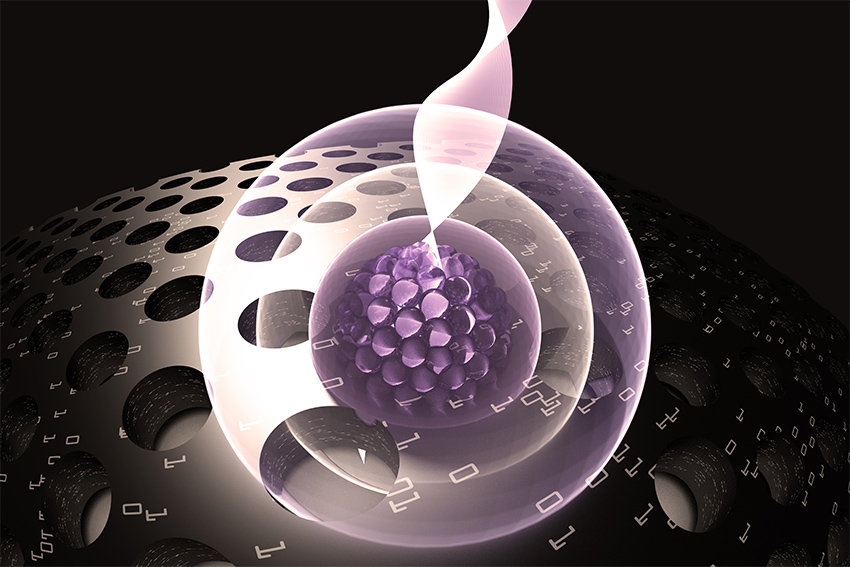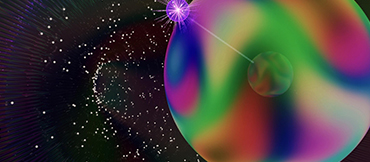Semiconductor Quantum Transistor Opens the Door for Photon-based Computing
- Details
- Category: Research News
- Published: Thursday, July 05 2018 14:12
Transistors are tiny switches that form the bedrock of modern computing—billions of them route electrical signals around inside a smartphone, for instance.
Quantum computers will need analogous hardware to manipulate quantum information. But the design constraints for this new technology are stringent, and today’s most advanced processors can’t be repurposed as quantum devices. That’s because quantum information carriers, dubbed qubits, have to follow different rules laid out by quantum physics.
Scientists can use many kinds of quantum particles as qubits, even the photons that make up light. Photons have added appeal because they can swiftly shuttle information over long distances and they are compatible with fabricated chips. However, making a quantum transistor triggered by light has been challenging because it requires that the photons interact with each other, something that doesn’t ordinarily happen on its own.
Now, researchers at the Joint Quantum Institute (JQI), led by JQI Fellow Edo Waks have cleared this hurdle and demonstrated the first single-photon transistor using a semiconductor chip. The device, described in the July 6 issue of Science, is compact: Roughly one million of these new transistors could fit inside a single grain of salt. It is also fast, able to process 10 billion photonic qubits every second.
“Using our transistor, we should be able to perf Researchers demonstrate the first single-photon transistor using a semiconductor chip. They used a single photon, stored in a quantum memory, to toggle the state of other photons. (Image Credit: E.Edwards/JQI)orm quantum gates between photons,” says Waks. “Software running on a quantum computer would use a series of such operations to attain exponential speedup for certain computational problems.
Researchers demonstrate the first single-photon transistor using a semiconductor chip. They used a single photon, stored in a quantum memory, to toggle the state of other photons. (Image Credit: E.Edwards/JQI)orm quantum gates between photons,” says Waks. “Software running on a quantum computer would use a series of such operations to attain exponential speedup for certain computational problems.
The photonic chip is made from a semiconductor with numerous holes in it, making it appear much like a honeycomb. Light entering the chip bounces around and gets trapped by the hole pattern; a small crystal called a quantum dot sits inside the area where the light intensity is strongest. Analogous to conventional computer memory, the dot stores information about photons as they enter the device. The dot can effectively tap into that memory to mediate photon interactions—meaning that the actions of one photon affect others that later arrive at the chip.
“In a single-photon transistor the quantum dot memory must persist long enough to interact with each photonic qubit,” says Shuo Sun, the lead author of the new work who is a Postdoctoral Research Fellow at Stanford University*. “This allows a single photon to switch a bigger stream of photons, which is essential for our device to be considered a transistor.”
To test that the chip operated like a transistor, the researchers examined how the device responded to weak light pulses that usually contained only one photon. In a normal environment, such dim light might barely register. However, in this device, a single photon gets trapped for a long time, registering its presence in the nearby dot.
The team observed that a single photon could, by interacting with the dot, control the transmission of a second light pulse through the device. The first light pulse acts like a key, opening the door for the second photon to enter the chip. If the first pulse didn’t contain any photons, the dot blocked subsequent photons from getting through. This behavior is similar to a conventional transistor where a small voltage controls the passage of current through it’s terminals. Here, the researchers successfully replaced the voltage with a single photon and demonstrated that their quantum transistor could switch a light pulse containing around 30 photons before the quantum dot’s memory ran out.
Waks, who is also a professor in the University of Maryland Department of Electrical and Computer Engineering, said that his team had to test different aspects of the device’s performance prior to getting the transistor to work. “Until now, we had the individual components necessary to make a single photon transistor, but here we combined all of the steps into a single chip,” Waks says.
Sun says that with realistic engineering improvements their approach could allow many quantum light transistors to be linked together. The team hopes that such speedy, highly connected devices will eventually lead to compact quantum computers that process large numbers of photonic qubits.
*Other contributors and affiliations
- Edo Waks has affiliations with the University of Maryland Department of Electrical and Computer Engineering (ECE), Department of Physics, Joint Quantum Institute, and the Institute for Research in Electronics and Applied Physics (IREAP).
- Shuo Sun was a UMD graduate student at the time of this research. He is now a postdoctoral research fellow at Stanford University.
- JQI Fellow Glenn Solomon, a physicist at the National Institute of Standards and Technology, grew the sample used in this research.
- Hyochul Kim was a postdoctoral research at UMD at the time of the research. He is now at Samsung Advanced Institute of Technology.
- Zhouchen Luo is currently a UMD ECE graduate student.
Paper reference
"A single-photon switch and transistor enabled by a solid-state quantum memory,” Shuo Sun, Hyochul Kim, Zhouchen Luo, Glenn S. Solomon, and Edo Waks, Science, 361, 57 (2018)
Research contact:
Edo Waks: This email address is being protected from spambots. You need JavaScript enabled to view it.
